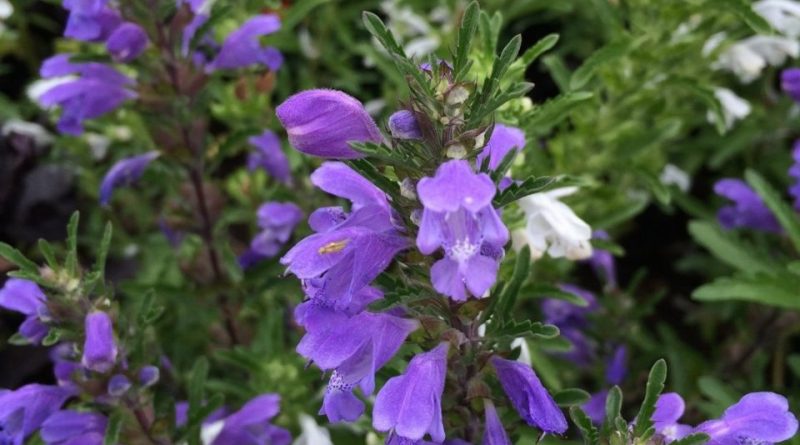Dracocephalum moldavica
Dracocephalum moldavica
Moldavian dragonhead (Dracocephalum moldavica L.) is a herbaceous species belonging to the Lamiaceae family.
Systematics –
From a systematic point of view it belongs to:
Eukaryota Domain,
Kingdom Plantae,
Magnoliophyta Division,
Magnoliopsida class,
Subclass Asteridae,
Lamiales Order,
Lamiaceae family,
Genus Dracocephalum,
D. moldavica species.
The terms are synonymous:
– Dracocephalum fragrans Salisb .;
– Moldavica moldavica (L.) Britton;
– Moldavica punctata Moench;
– Moldavica silky Stokes;
– Moldavica suaveolens Gilib .;
– Nepeta moldavica (L.) Baill .;
– Ruyschiana moldavica (L.).
Etymology –
The term Dracocephalum comes from the Greek δράκων drácon drago and from κεφαλή cephalé testa: dragon head.
The specific Moldavian epithet is in relation to Moldova, a geographical region of Eastern Europe now divided politically between Romania and the Republic of Moldova.
Geographic Distribution and Habitat –
Moldavian dragonhead is a plant native to the southern regions of Siberia and the area of the Himalayas and western China, but is now also naturalized in Central and Eastern Europe.
Its habitat is that of dry hills, stony embankments and valleys at altitudes between 200 and 2,700 meters in western China.
Description –
Moldavian dragonhead is an annual herbaceous plant with an erect stem, which usually grows from 60 cm up to 150 cm.
Each plant carries 7-9 branches that start from the base and almost reach the maximum height of the plant.
The leaves are dark green and covered with short hairs.
The flowers, lilac – purplish in color, have a calyx of about 10 cm, typically tubular bilabiate.
The fruit is a schizocarp composed of 4 nuculae.
Cultivation –
Moldavian dragonhead is a plant that tolerates the cold climate well and prefers arid soils both in the valley floor and in alpine and sub-alpine areas.
It succeeds in a sunny location in fertile, well-drained soil.
This plant, which grows spontaneously, is sometimes grown for its essential oil.
It is a very fragrant plant, with leaves and flowers that give off a refreshing scent of lemons.
The flowers remain fragrant and fresh for several weeks.
This plant can be propagated by seed, with sowing in early spring in situ. Pollination occurs through insects (entomogamous pollination) such as diptera and hymenoptera, that is, bees, wasps, butterflies, moths, flies, beetles and even birds.
Customs and Traditions –
The first morphological and functional description of D. moldavica is found in the “Herbario Novo” by the doctor Castore Durante of 1584.
This plant is harvested in nature for local use as a food, medicine and source of materials.
Since ancient times it was believed that the derivatives of the plant were able to give “relief to the stomach and the brain”, while the distillate was to “comfort the skin”. The leaves give off an aroma reminiscent of lemon, while the flowers have a very marked purple color that attracts bees, making the harvesting period quite lively. The common name “lemon balm” is in fact linked to the abundant production of bees of a particularly aromatic honey.
The essential oil of Dracocephalum moldavica has been, and still is, the object of deep attention by the scientific community, with many researches, published in various scientific journals, which study its composition and properties.
In countries where this plant grows spontaneously, its use is part of the popular tradition. The flowering tops and the dried leaves are used as flavoring in foods and drinks. In fact, by rubbing a leaf of this plant it will be possible to perceive the intense citrus scent, given by the high content in citrals.
From the aerial parts of this plant, an essential oil is extracted by distillation with a good content of citrals, geraniol, linalool, flavonoids, caffeic acid and derivatives. This composition gives the essential oil excellent cosmetic properties, mainly due to the generic emollient properties, but also to the specific antibacterial and antifungal properties given by the rich composition.
Furthermore, the seeds are astringent, carminative and tonic; they are used as emollients in the treatment of fever and the plant is astringent, tonic and vulnerable.
Preparation Method –
The scented leaves are used to make a tea.
The plant contains an essential oil which is extracted by distillation and which has properties yet to be explored.
Guido Bissanti
Sources
– Acta Plantarum – Flora of the Italian Regions.
– Wikipedia, the free encyclopedia.
– Useful Tropical Plants Database.
– Conti F., Abbate G., Alessandrini A., Blasi C. (edited by), 2005. An annotated checklist of the Italian vascular flora, Palombi Editore.
– Pignatti S., 1982. Flora of Italy, Edagricole, Bologna.
– Treben M., 2000. Health from the Lord’s Pharmacy, Advice and experiences with medicinal herbs, Ennsthaler Editore.
Warning: Pharmaceutical applications and alimurgical uses are indicated for informational purposes only, they do not represent in any way a medical prescription; therefore no responsibility is taken for their use for curative, aesthetic or food purposes.


